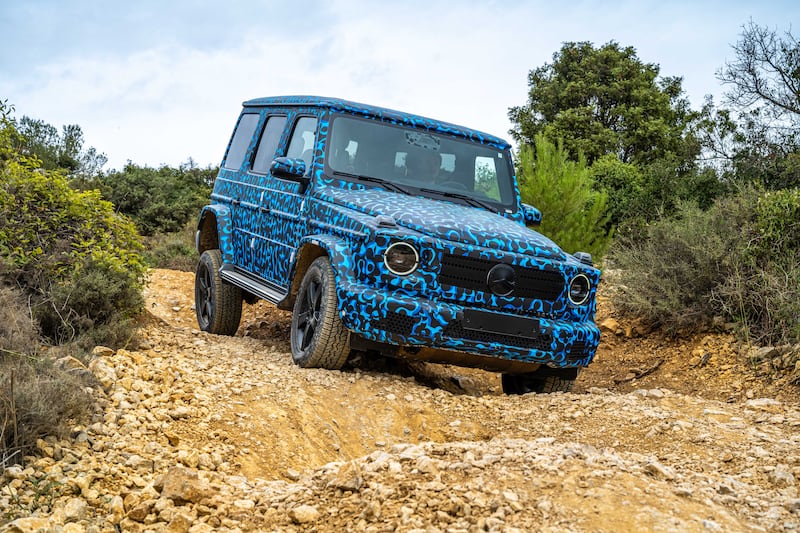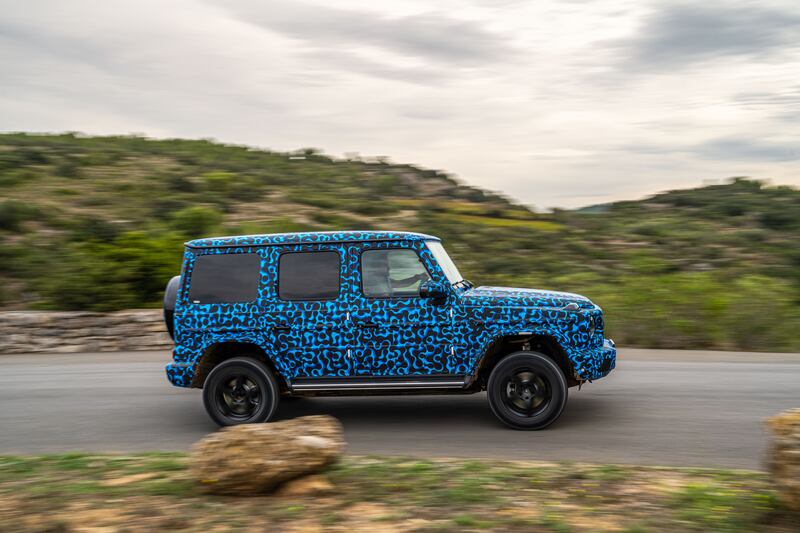I’m sitting in the familiar surroundings of a Mercedes-Benz G-Class, but what’s just happened is more like a fairground ride than anything I’ve ever experienced in a car before. There’s dust everywhere, and the G-Class pointing in an entirely different direction from where it was a moment ago.
It’s just repeatedly rotated within its own length, doing so by spinning the wheels on either side in opposite directions, this G-Class able to turn like a tracked vehicle, because it’s got four motors. One for each wheel.
This is a G-Class like no other, then. Those four motors are electric, and powered by a battery. It’s a prototype, as the swirly “disguise” snickering outside underlines, of what will become the EQG, a plug-in, fully electric G-Class.
As a statement of intent and commitment to electrification, Mercedes-Benz’s decision to add batteries to its famous G-Class couldn’t be more frank. Emmerich Schiller, chief executive of Mercedes-Benz’s G-Class, admits it’s not been easy either, because the G-Class holds a unique position within the company, and one that dictates it must be a true off-roader. The EQG doesn’t get a pass on the trial that defines all G-Class, that being 2,000km of punishing testing on tracks that criss-cross Schöckl Mountain, which towers over the G-Class’s home in Graz, Austria.
Sally Rooney: ‘I enjoy writing about men ... the dangerous charisma of the oppressor class’
Alzheimer’s: ‘I’ve lost my friend and my companion,’ says Úna Crawford O’Brien of fellow Fair City actor Bryan Murray
Ryan Adams at Vicar Street: A gig that nobody will forget anytime soon, but perhaps not for all the right reasons
Meghan Markle’s new podcast: An ego-fluffing conversation underlining the culture gap between Ireland and the US

Schiller states: “the G-Class is not an SUV, it’s a 4x4,” so there’s been no shortcut to production, the EQG not simply using one of Mercedes-Benz’s skateboard platforms and popping a G-Class-aping body on top. Instead, it retains its body on frame chassis, with a great deal of engineering work going into housing the battery within those frame rails, as well as protecting it from the sort of abuse that a true off-roader will subject it to.
The performance the EQG delivers doesn’t in any way feel like it’s lacking
What the battery, or the motor specifications are, nobody’s prepared to admit this early in the EQG’s development, but it’s improbable that the EQG will pack a battery with any less than the 108kWh that’s currently available in the EQS and EQS SUV. Mercedes-Benz is known to have registered the EQG 560 and EQG 580 names, giving some weight to the rumours that the EQG might be the first EQ model to be the recipient of new battery tech that Mercedes-Benz is working on, which is expected to add around 20 per cent in energy density, the possibility being that the EQS 580 will adopt that battery choice.
The engineers’ poker faces give a tell when we suggest the EQG will weigh in at around 20-30 per cent more than the combustion cars, which would mean up to a hefty 3,000kg. Despite that, it feels light and quick, which would suggest those four motors are producing at combined output in the region of 450-500kW, and possibly more.
That’s greater than the Mercedes-AMG G63 manages from its 4.0-litre twin-turbo V8, and, certainly, the performance the EQG delivers doesn’t in any way feel like it’s lacking. Indeed, off-road, at one of Mercedes-Benz’s preferred testing areas in Carcassonne, France, the EQG is absolutely monstering the terrain. Usefully, it’s the same place we drove its internal combustion relations on the launch back in 2018, so we know just how tough it is, and there’s one ahead of us now containing the photographer.

The driver of the G500 in front isn’t struggling as such, but it’s clear it’s not having as easy a time around the ridiculously challenging terrain the EQG is shrugging off with impunity. In the EQG each of the electrics motor has its own low-ratio transfer ‘box, while the instant torque electric motors deliver, as well as the ability to manage the power between all four wheels means the EQG is arguably better equipped to cope with the conditions over the many locking differentials that the G500 ahead features.
Its effortless goat-like climbing and descending ability here is redoubled by the fact that there’s no sound other than the quiet crunch of the surface under the tyres, or a worrying thump when Schiller deliberately bottoms out the EQG on a protruding rock to demonstrate just how well his team has engineered the protection for the battery.
It’s quite ridiculously capable around what pass for tracks up and down the precipitous valley sides, it treading authoritatively, but quietly, and leaving nothing behind it but tyre tracks, unlike all the G-Classes that have been here before it.

I joke that sommeliers might note a difference in the grapes from the vineyard in the valley below, the wine from now on perhaps lacking a hint of burnt hydrocarbons as a result of the G’s new propulsion. They will still certainly be able to detect a soupcon of earthy dustiness, thanks to all those G-Turns the engineers can’t help but keep ‘testing’.
As a demonstration that electrification is not just a necessity but an opportunity, the EQG is an impressive one, retaining all the ability of its combustion-engined relations and actually adding to it.
None of that has come easily as the engineers admit, nor will it come cheaply when it comes to the market in 2024, the expectation being that it’ll cost around 10 per cent more than the E63 AMG, so in excess of €400,000. A lot of money, then, but the G-Class has never been cheap, and in EQG guise it’s never been more capable, or indeed more desirable.













